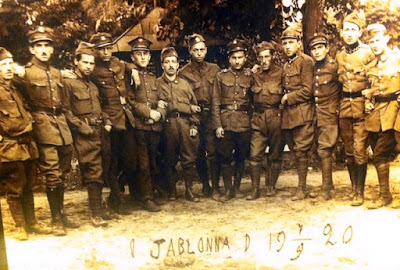POLIN tells history of Poland from Jewish perspective since before Poland was a country. This history is long and complex. I've spent about 4 hours in this museum, and I felt like I only touched on some subjects. I am not going to give you a complete picture in this blog, rather some interesting or new to me, bits of information, which may encourage you to study the subject in more depth.
Jewish and Muslim merchants have been travelling the low lands of today's Poland to buy slaves for Muslims until at least XII century. The male slaves were castrated before being put to work. The English word 'slave' originates from the name of people living in central Europe around 1000 years ago: Slavs. The word 'slav' originates from 'slovo' - 'word'.
 |
| "Jews call the land of Slavs 'Kanaan', because inhabitants of these lands sell their sons and daughters." Beniamin from Gudela, Book of Travels, XII century. |
Jews settled in Poland on invitation from the rulers. They were minting coins and collecting taxes for the kings.
Sometimes the rulers had more intimate relations with Jewish women:
Jews were courted to settle in Poland, because they were critical to the development of trade and finance. This reminds me of how countries now try to attract foreign capital to invest in special economic zones by letting them not pay taxes for a number of years.
Jews were given privileges, but from early on they also suffered from accusations of ritual murder, starting fires, and sacrilege.
A side note: it seams that already in XII century, 'German' was synonymous with 'order':
 |
| The German law is also known as Magdeburg law. |
Any country that lets many people suffer, while some profit from their suffering, is bound for trouble in the future.
And in the east of the Polish-Lithuanian Commonwealth the trouble came in the form of murder of those seen as oppressors.
With time, the number of Jews in Poland grew, to the point where many cities were predominantly Jewish, and of course not all Jews were rich. After the first partition of Poland in 1772, for example, Prussia expelled at least 40 thousand poor Jews - 'Betteljuden' - most of whom re-settled in what remained of the Commonwealth.
The industrial revolution created some very rich Jewish industrialists, and many poor Jewish workers. The workers revolted in 1905:
The life for Jews in reborn Poland, did not start well. During the war with Soviet Russia, Jews were sometimes accused of collaboration with communists and killed.
 |
The museum also documents the chilling progression of laws in Warsaw under German occupation:
- October 1939: ban on Jews entering shops, cafes, and restaurants; Jews ordered to bow to Germans on the street;
- Mid October 1939: freezing of bank accounts for Jews; ban on holding more than 2000zł in cash;
- 18 October 1939: Jews prohibited from trading furs and textiles;
- 26 October 1939: ban on ritual slaughter;
- 30 October 1939: resettlement of Poles and Jews from areas incorporated into Germany to General Government;
- 15 November 1939: temporary closure of Polish and Jewish elementary and high schools under the pretext of typhus;
- November 1939: Jewish companies under forced administration;
- December 1939: ban on returning to Jews items from pawn shops;
- 1 December 1939: blue star of David on white background must be worn on right arm by all Jews over 12 years old; all Jewish shops and enterprises must be marked; introduction of trams reserved only for Germans;
- 7 December 1939: Polish schools (not universities) open with reduced curriculum; Jewish schools stay closed;
- 12 December 1939: mandatory work for Jews 14-60 years old; for Poles 18-60 years old;
- 15 December 1939: food rationing - Poles and Jews get the same rations initially;
- 31 December 1939: end of pension payments, health services to Jews;
- January 1940: closing of synagogues; ban on group prayers in private homes; separation of Polish and Jewish social services institutions;
- 1 January 1940: Jews cannot move (change where they reside);
- 8 February 1940: Jews forbidden to travel by train;
- February - May 1940: food rations for Jews lowered;
- March 1940: ban on employing Jews in restaurants, cabarets, etc.
- April-June 1940: building of a wall around an 'area susceptible to disease';
- 19 April 1940: curfew: 10pm for Poles, 9pm for Jews;
- May-July 1940: food rations for Jews lowered again; coupons accepted only in Jewish shops;
- Mid 1940: taking over Jewish apartments; closing of Jewish libraries and book shops; ban on Jewish pharmacies, dentistry offices, medical laboratories, treating on non-Jewish patients by Jewish doctors; Jewish lawyers forbidden to practice law;
- July 1940: ban on most political, social, and non-profit organisations; ban on borrowing books to Jews;
- 18 July 1940: Jews banned from entering public parks, using benches, walking certain streets;
- 7 August 1940: forced relocation of Jews in Warsaw starts: first from German district, then Polish, newcomers must settle in Jewish district;
- September 1940: Jews only tram;
- 7-9 September 1940: bread rationing restricted to 1500 grams per week for Poles, and 750 grams for Jews;
- 6 October 1940: curfew changes: for Poles from 11pm to 4am, for Jews from 9pm to 5 am;
- 12 October 1940: mail censorship; mail from ghetto can be sent only to countries not at war with Germany;
- November 1940: Judenrat tasked with removal of Jewish patients from municipal hospitals and care centres;
- 16 November 1940: closing of the ghetto in Warsaw; 138 thousand Polish Jews and 113 thousand non-Jewish Poles were relocated to create it; in 1941 450 thousand people lived in this 307 hectare (a little over 3 square km) district;
 |
| Jewish police guarding the ghetto gate. |
After the war, most surviving Polish Jews left communist Poland.












No comments:
Post a Comment